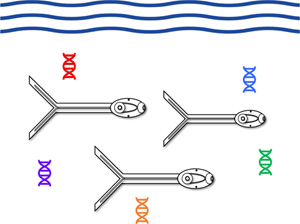Finding all of the parasites
The latest Paper of the Month for Parasitology is “Lurking in the water: testing eDNA metabarcoding as a tool for ecosystem-wide parasite detection” and is freely available for one month.
The tricorder technology used in the science fiction television series Star Trek enabled the crew of the Starship Enterprise to quickly assess the biodiversity of an unknown ecosystem. This technology is quickly becoming a reality. DNA can be left in the environment (termed eDNA) from various sources, including shed skin cells, mucus and hair. Traces of this eDNA can be found in all types of environments, from lakes, the deep-sea, soil and even the air. The first developments in this technology came with the use of DNA barcodes to identify single species. These small DNA fragments are regions of the genome that are conserved throughout the tree of life but contain enough variation in the DNA sequence to distinguish between different species. Recently, it is has become possible to analyse traces of DNA left in the environment from multiple to barcode multiple species.

The use of eDNA is quickly becoming a routine tool for ecosystem and biodiversity monitoring, and promises to be a valuable tool for parasitology. The identification of parasites to species-level via traditional methods requires a high degree of expertise, and unfortunately, the number of experts with the necessary taxonomic knowledge is in decline. These traditional methods of detecting parasites generally require lethal sampling of host organisms. Not only does such sampling raise ethical and conservation concerns, but it is labour intensive, and it can easily fail to detect parasites that occur only in a small fraction of hosts – leading to false negative results. Using eDNA methods can circumvent these problems, but before it becomes a routine tool in parasitology, its reliability needs to be examined. In our study, we compared parasite species detected through eDNA metabarcoding to a comprehensive and detailed dataset compiled using traditional survey methodology that had precisely identified all of the parasites found in two New Zealand lakes. Our findings showed that eDNA methods were able to detect parasite DNA from water samples, but a problem revealed by the study is the current lack of sequence data available online for most parasite species. This means that while we found the desired parasite DNA barcode in the environment, there was no reliable reference database to match it to , meaning most parasite species could not be confidently identified to the species-level. For the time being, we encourage parasitologists to genetically categorise parasites obtained through traditional sampling methods to construct a more comprehensive reference database. Considering the current biodiversity crisis, constructing a well-curated reference database for all of life is something that the greater scientific community should be focusing on if eDNA methods are to be a used as a tool for species conservation and monitoring; ultimately bringing us one step closer to the final frontier of Star Trek’s tricorder technology.
The paper “Lurking in the water: testing eDNA metabarcoding as a tool for ecosystem-wide parasite detection” by Dr Leighton Thomas, published in Parasitology, is available free for a month.






